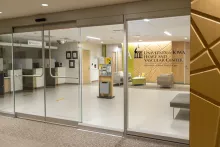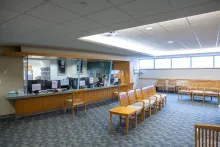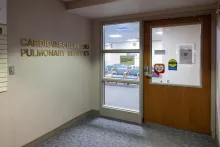Echocardiogram
- For all other requests:
- 1-800-777-8442
An echocardiogram is a test that takes pictures of the heart.
These pictures show whether certain parts of your heart, such as the valves, work properly. They also show problems like heart muscle weakness and holes between the heart’s chambers.
The University of Iowa Heart and Vascular Center’s certified echocardiogram technicians use the most up-to-date equipment and technology available. This helps us make sure your echocardiogram images are of the highest quality, so our cardiologists can evaluate them with ease and accuracy.
How an echocardiogram works
An echocardiogram is a noninvasive procedure. It uses sound waves instead of radiation to capture images of your heart.
During a standard echocardiogram, a wand-like device called a transducer sends sound waves through your chest to your heart. When these sound waves reach your heart, they bounce back and create echoes.
The transducer records these echoes, and a computer converts them into moving pictures that can be viewed on a monitor and recorded.
Other types of echocardiograms
In some cases, your provider may need more detailed images than a standard echocardiogram can provide. The following are other types of echocardiograms we offer.
Echocardiogram with contrast
If your provider orders an echocardiogram with contrast, you’ll receive a harmless liquid solution called a contrast agent. It will be given through an IV in your arm at the start of the procedure.
Because the contrast agent reflects ultrasound waves, it helps certain cardiovascular problems stand out. They’ll show up more clearly on the monitor. Compared to standard echocardiograms, contrast echocardiograms are better at showing how well blood flows through the heart.
If you’re allergic to the contrast agent used during CT scans, you can still have a contrast echocardiogram. Even though they’re both referred to as contrast agents, the solution used during echocardiograms is different than the liquid dye used with CT.
Stress test (stress echocardiogram)
Some cardiovascular conditions, including coronary artery disease, worsen during exercise. If your provider wants to see how your heart functions during physical activity, you may need a stress echocardiogram.
During this procedure, you’ll undergo an echocardiogram while at rest, then again after walking on a treadmill or riding a stationary bike.
Transesophageal echocardiogram (TEE)
This test combines echocardiogram with a procedure called endoscopy.
Your provider will guide a thin tube called an endoscope down the back of your throat and into your esophagus, which runs right behind the heart. Just like with a standard echocardiogram, the transducer records the sound wave echoes that bounce off your heart.
You’ll receive medicine to help you relax and stay comfortable during your TEE.
What to expect during a standard echocardiogram
Your echocardiogram will probably take about an hour from start to finish.
During your procedure
An echocardiogram usually includes the following steps:
- First, we’ll help you lay on your left side, on a special bed.
- Next, we’ll attach sticky metal discs called electrodes to your chest. These electrodes are attached by wire to a machine that keeps track of your heart rate.
- Your sonographer will slowly move the wand over your chest to capture sound wave echoes from different angles. You may occasionally need to hold your breath or shift positions.
- Once your echocardiogram is complete, we’ll remove the electrodes. You can then go home or return to your normal activities.
After your procedure
The images recorded during your echocardiogram will be read by a cardiologist with special training in cardiac imaging. The cardiologist will write a report summarizing the results of your procedure and send it to the provider who ordered your echocardiogram.
Your provider will help you understand what the test showed and, if necessary, discuss next steps including further testing or potential treatments.
Who can benefit from an echocardiogram?
If your provider thinks you might have cardiovascular disease, an echocardiogram can provide answers. It helps identify problems with the heart’s structure or function, such as unusually thick walls, leaky valves, and pumping problems.
These signs of illness or damage can help confirm whether you have one of the following conditions:
- Heart failure
- Heart valve disease, including aortic stenosis and mitral valve prolapse
- Hypertrophic cardiomyopathy (abnormal thickening of the heart muscle)
- Pericardial effusion (fluid build-up around the heart)
- Shunt structural abnormalities, such as atrial septal defect and patent foramen ovale
Our Care Team







- Heart and Vascular

- Heart and Vascular




- Heart and Vascular

Need help taking the next steps for an echocardiogram?
Locations and Offices


